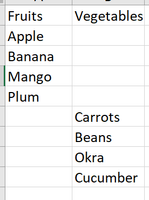FabCon is coming to Atlanta
Join us at FabCon Atlanta from March 16 - 20, 2026, for the ultimate Fabric, Power BI, AI and SQL community-led event. Save $200 with code FABCOMM.
Register now!- Power BI forums
- Get Help with Power BI
- Desktop
- Service
- Report Server
- Power Query
- Mobile Apps
- Developer
- DAX Commands and Tips
- Custom Visuals Development Discussion
- Health and Life Sciences
- Power BI Spanish forums
- Translated Spanish Desktop
- Training and Consulting
- Instructor Led Training
- Dashboard in a Day for Women, by Women
- Galleries
- Data Stories Gallery
- Themes Gallery
- Contests Gallery
- QuickViz Gallery
- Quick Measures Gallery
- Visual Calculations Gallery
- Notebook Gallery
- Translytical Task Flow Gallery
- TMDL Gallery
- R Script Showcase
- Webinars and Video Gallery
- Ideas
- Custom Visuals Ideas (read-only)
- Issues
- Issues
- Events
- Upcoming Events
The Power BI Data Visualization World Championships is back! Get ahead of the game and start preparing now! Learn more
- Power BI forums
- Power BI Spanish forums
- Translated Spanish Desktop
- Re: PowerQuery - Datos semiestructurados en tabla
- Subscribe to RSS Feed
- Mark Topic as New
- Mark Topic as Read
- Float this Topic for Current User
- Bookmark
- Subscribe
- Printer Friendly Page
- Mark as New
- Bookmark
- Subscribe
- Mute
- Subscribe to RSS Feed
- Permalink
- Report Inappropriate Content
PowerQuery - Datos semiestructurados en tabla
Hola
Tengo un archivo csv que está semiestructurado. Necesito poder extraer la información que quiero y volver a presentarla de manera tabular. He intentado rellenar a partir del ejemplo y no está funcionando tan bien como quiero.


Quiero convertir el archivo de origen sin encabezados en una tabla que se parezca a la segunda tabla.
He intentado discutirlo con powerquery varias veces, desafortunadamente parece que no puedo descubrir cómo separar las filas superiores de las inferiores y los dos tipos diferentes de estadísticas capturadas. Cualquier ayuda será muy apreciada.
Aquí está el enlace al archivo fuente del archivo fuente
- Mark as New
- Bookmark
- Subscribe
- Mute
- Subscribe to RSS Feed
- Permalink
- Report Inappropriate Content
Necesito un tipo de ayuda similar. Necesito poder separar una columna de datos en varias columnas donde aparece un determinado delimitador.
Quiero dividir esta columna en varias columnas por : delimitador. Quiero crear una nueva columna en todas partes: aparece el delimitador. Sé cómo encontrar la posición del delimitador, pero no sé cómo recorrer cada instancia. A continuación se muestra el resultado final que espero lograr.
- Mark as New
- Bookmark
- Subscribe
- Mute
- Subscribe to RSS Feed
- Permalink
- Report Inappropriate Content
Muchas gracias por la ayuda en esto. Comencé subconfigurando datos del conjunto de datos original, pero mirando su código, puedo omitir varios de los pasos que estaba haciendo. Este es un enfoque mucho mejor con menos pasos de los que había comenzado. Gracias un millón de veces 🙂
- Mark as New
- Bookmark
- Subscribe
- Mute
- Subscribe to RSS Feed
- Permalink
- Report Inappropriate Content
Pruebe este código M:
let
Source = Csv.Document(File.Contents("C:\Users\Admin\Desktop\data.csv"),[Delimiter=",", Columns=9, Encoding=1252, QuoteStyle=QuoteStyle.None]),
#"Changed Type" = Table.TransformColumnTypes(Source,{{"Column1", type text}, {"Column2", type text}, {"Column3", Int64.Type}, {"Column4", Int64.Type}, {"Column5", Int64.Type}, {"Column6", Int64.Type}, {"Column7", Int64.Type}, {"Column8", Int64.Type}, {"Column9", Int64.Type}}),
#"Removed Top Rows" = Table.Skip(#"Changed Type",10),
#"Added Custom" = Table.AddColumn(#"Removed Top Rows", "blank", each null),
#"Transposed Table" = Table.Transpose(#"Added Custom"),
#"Filled Down" = Table.FillDown(#"Transposed Table",{"Column1", "Column9"}),
#"Transposed Table1" = Table.Transpose(#"Filled Down"),
#"Filled Down1" = Table.FillDown(#"Transposed Table1",{"Column10"}),
#"Filtered Rows" = Table.SelectRows(#"Filled Down1", each [Column1] <> "" and [Column1] <> "Result Type:"),
#"Promoted Headers" = Table.PromoteHeaders(#"Filtered Rows", [PromoteAllScalars=true]),
#"Changed Type1" = Table.TransformColumnTypes(#"Promoted Headers",{{"Week", type text}, {"Person", type text}, {"1", Int64.Type}, {"2", Int64.Type}, {"3", Int64.Type}, {"4", Int64.Type}, {"5", Int64.Type}, {"6", Int64.Type}, {"7", Int64.Type}, {"Average", type text}}),
#"Filtered Rows1" = Table.SelectRows(#"Changed Type1", each ([Week] <> "Week")),
#"Renamed Columns" = Table.RenameColumns(#"Filtered Rows1",{{"Average", "Type"}}),
#"Unpivoted Other Columns" = Table.UnpivotOtherColumns(#"Renamed Columns", {"Week", "Person", "Type"}, "Attribute", "Value"),
#"Renamed Columns1" = Table.RenameColumns(#"Unpivoted Other Columns",{{"Attribute", "Day of week"}}),
// date
#"Kept First Rows" = Table.FirstN(#"Changed Type",3),
#"Transposed Table_date" = Table.Transpose(#"Kept First Rows"),
// Time in, Time out, Date
#"Timein" = #"Transposed Table_date"{1}[Column1],
#"Timeout" = #"Transposed Table_date"{1}[Column2],
#"Date" = #"Transposed Table_date"{1}[Column3],
// Add column
#"Added column" = Table.AddColumn(#"Renamed Columns1","Time in", each #"Timein"),
#"Added Custom1" = Table.AddColumn(#"Added column", "Time out", each #"Timeout"),
#"Added Custom2" = Table.AddColumn(#"Added Custom1", "Date", each #"Date"),
#"Reordered Columns" = Table.ReorderColumns(#"Added Custom2",{"Date", "Time in", "Time out", "Week", "Person", "Type", "Day of week", "Value"}),
#"Changed Type2" = Table.TransformColumnTypes(#"Reordered Columns",{{"Date", type date}, {"Time in", type datetime}, {"Time out", type datetime}})
in
#"Changed Type2"
Resultado:
Pbix al final puedes referirte.
Saludos
Equipo de apoyo a la comunidad _ chenwu zhu
Si esta publicación ayuda, considere Aceptarla como la solución para ayudar a los otros miembros a encontrarla más rápidamente.
Helpful resources

Power BI Dataviz World Championships
The Power BI Data Visualization World Championships is back! Get ahead of the game and start preparing now!

Power BI Monthly Update - November 2025
Check out the November 2025 Power BI update to learn about new features.




